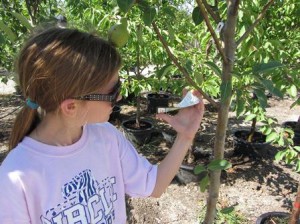 School’s out for the summer, however, I am still going to the school every day as construction on the outdoor classroom and learning garden continues. This week, we went to the local nursery to pick out fruit trees. Choosing what and where to plant takes research and thought. I have compiled a list of things we took into consideration when we selected the plants that will transform the courtyard into a platform for hands-on learning through nature.
School’s out for the summer, however, I am still going to the school every day as construction on the outdoor classroom and learning garden continues. This week, we went to the local nursery to pick out fruit trees. Choosing what and where to plant takes research and thought. I have compiled a list of things we took into consideration when we selected the plants that will transform the courtyard into a platform for hands-on learning through nature.
- The school calendar
- Plant trees, shrubs and perennials that will be blooming and showy when the students can see them and learn from them. We follow the traditional school calendar. School starts late August and releases in mid-to-late May. Therefore, we chose plants that have spring, fall, and winter interest.
- In the garden, we are going to plant cold hardy crops. By using cold tolerant vegetables, it will ensure that the students will see the entire life cycle of the plant, from planting to harvesting. Cold hardy crops include lettuce, spinach, radishes, turnips, broccoli, cabbage, peas and potatoes. I know this is not as exciting as tomatoes, sweet corn and green beans, but the benefits of kids eating what they planted are an important aspect of the learning garden experience. Those of you teaching in the southern states have a much warmer school year. Therefore, you will be able to branch out and plant a large variety of vegetable crops. Each vegetable and fruit has a “days to maturity” classification. This will be helpful to look at when planning your learning garden.
- Perennial crops, such as rhubarb, strawberries, and asparagus would also be a good addition to the learning garden. Consider your garden zone and consider if the crops will be harvestable before school lets out.
- We have included fruit trees in our outdoor classroom. We carefully selected varieties of pear and apples trees that will mature in September. I can hardly wait for our trees to mature enough to enjoy a harvest party of fresh pears and apples. School curriculums are full of apple activities. It will be fun to see how the teachers incorporate these fruits into our students’ education.
- We will leave the gardens fallow in the summer, unless a group wants to adopt the garden for the summer. Summer is busy and it is hard to find teachers and volunteers that want to visit the school every day to maintain the garden. Therefore, we simply leave them empty and waiting for the students to arrive for fall planting.
- Safety
- Choose plant species that are not thorny, prickly, or poisonous. I know you are not intentionally going to plant poison ivy, but it is worth mentioning here. Wildlife spreads poison ivy easily. Continually check the outdoor classroom for this invasive and itchy plant. In addition, we want the students to taste the vegetables grown in the learning garden, but we do not want them to taste everything. Many common ornamental plants can make you sick if you eat them. Therefore, we must teach our students not to nibble unless approved by the teacher.
- Maintenance
- It is important to select plant species that do not require a lot of extra care and water. We tried to select many native species. Native plants have adapted to the local weather, climate and soil. They are hardy and less susceptible to pests and disease.
- Wildlife
- Mammals, birds and insects will naturally be a part of the outdoor classroom and learning garden. Attracting wildlife will provide opportunities for observation, identification, study and enjoyment. I have walked through a school garden and been “educated” by a second grade boy who identified every insect we saw. It was an amazing experience and a testament to how a child’s entire school education was transformed because he was given the opportunity to learn through nature. There are long list of plants that attract wildlife and can be found at your local County Extension office.
I would highly recommend making an appointment with your local County Extension office or garden center. They will be able to make recommendations that will help guide your plant selection process. The trees and shrubs are a large portion of our budget, in the end, the time we spend now researching and planning will benefit our school, our students, and our environment for decades.

Read more about classroom gardens in our Learning Garden blog series:
Learning Garden 2: Long-Term Sustainability
Learning Garden 4: Designing the Garden
Learning Garden 7: Raised Beds
Learning Garden 8: Plant Selection
Learning Garden 9: Rain Barrels
Learning Garden 10: How Does Your Garden Grow?
Learning Garden 11: Planting Day
Learning Garden 12: Teach the Teacher
Learning Garden 13: First Harvest
Learning Garden 14: How Do You Say Thank You
Learning Garden 15: Plant a Seed and Watch It Grow
Learning Garden 16: From the Learning Garden to the Cafeteria





